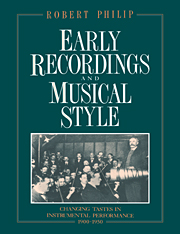1 - Flexibility of tempo
Published online by Cambridge University Press: 22 September 2009
Summary
Many writers from the end of the nineteenth century and the early years of the twentieth century recommend flexibility of tempo, and reject the idea that a piece of music should be played at a constant pace. Hugo Riemann (1897), writing on expression, advises,
First of all, in the matter of small changes of tempo, it may be remarked that hurrying implies intensification, and drawing back, the reverse; hence, as a rule, a slight urging, pressing forward is in place when the musical development becomes more intense, when it is positive; and, on the other hand, a tarrying, when it approaches the close. These changes must naturally be exceedingly minute in detached musical phrases, but can already become more important in a theme of a certain length; while for whole movements they are of such extent as to be seldom ignored in the notation.
The singer David Ffrangcon-Davies (1906), in a book prefaced by Elgar, writes: 'An inelastic time-measurer, can never give us characteristic Bach or Beethoven, Mozart or Wagner. Metronome marks are never more than approximate at best.' Arnold Dolmetsch (1916) argues that alterations of time are 'as old as music itself', and states, 'It is obvious that emotional feeling, if there be any, will cause the player to linger on particularly expressive notes and to hurry exciting passages.'
- Type
- Chapter
- Information
- Early Recordings and Musical StyleChanging Tastes in Instrumental Performance, 1900–1950, pp. 7 - 36Publisher: Cambridge University PressPrint publication year: 1992



